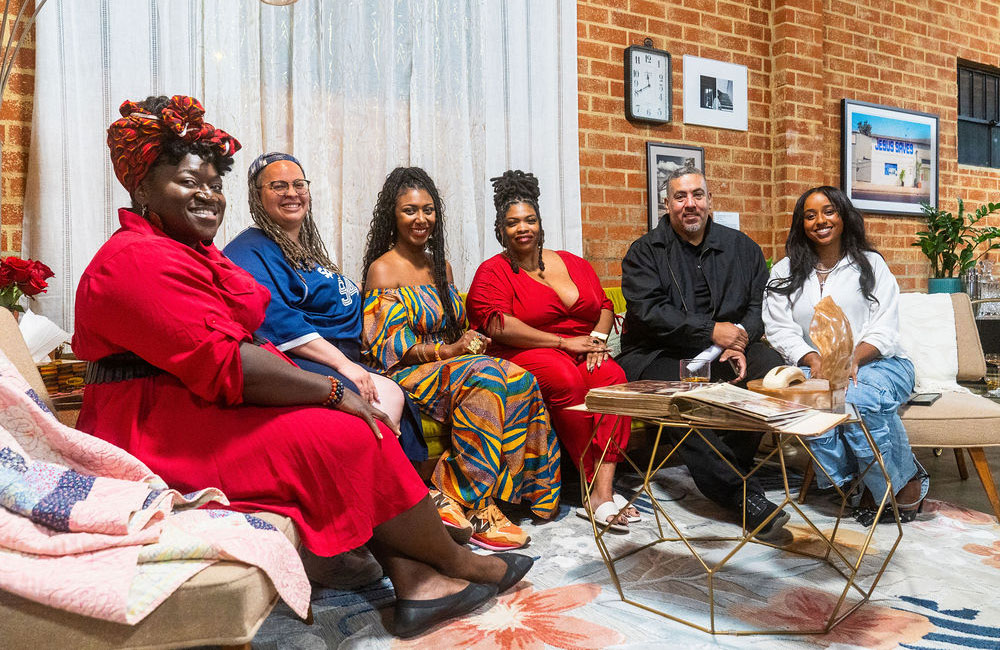Five Years of Media 2070: Repairing Media Harm & Reimagining Our Future
October 6, 2025

The Media 2070 team gathers in the grandmother’s living room at L.A.’s Black Future Newsstand, Riot to Repair . Photo Credit: Halline Overby.
October marks the fifth anniversary of Media 2070.
What began as a visionary essay has grown into a national effort to reimagine—and transform—media itself. From academic partnerships and petitions to traveling installations and newsroom repair work, we have spent the past five years tackling a central truth: a just, multiracial democracy is impossible without media reparations. Now, let’s build anew:
From Essay to Movement
The release of An Invitation to Dream Up Media Reparations, our essay documenting the long history of anti-Blackness in U.S. media did more than recount harm. It issued a call to reconcile, repair, and dream of a media system rooted in abundance, care, and Black self-determination. We explored real examples of harm, including:
- The use of advertising to sell enslaved people and gain profit directly for news outlets
- How community news covered issues of violence and narrative crafting
- The coup led by a newspaper publisher who wielded his power to dismantle a democratically elected Black government
That invitation launched a movement that has only expanded over the past five years. Here’s how:
Bringing Reparations Research to Life
In all aspects, Media 2070 works to ground theory, showcasing real-world examples of harm – as well as repair. In fact, the Black in the Newsroom documentary (our next major project after the essay) was one of the first times many saw the reality of working in news– through the lens of Elizabeth Montgomery, a Black journalist who was underpaid and overworked, just like many, many other Black journalists in America. This challenges our ability to use those already in newsrooms to make real change because many report being underpromoted as well– not often given opportunities to shape stories that will run. This demonstrates the need for systemic solutions– not ad hoc hiring proposals and mentorship programs.
And we’re not the only ones to notice this. Working with our growing network, we’ve encouraged newsrooms to sign our care pledge and more than 3,000 people signed Media 2070’s petition urging newsrooms across the country to dismantle anti-Black racism in their operations and storytelling.
These efforts grounded the research in lived newsroom experiences and created an early blueprint for collective repair, both inside the newsroom for Black journalists brave enough to tell important stories, and outside of it for communities who digest this news.
Building Curricula and Training the Next Generation
With an eye always on the future, we also partnered with colleges and universities to develop curricula that integrate the history and practice of media reparations into classrooms. This coupled with earlier efforts to address both past and current harm, provided a holistic approach to what many saw as an issue too large to tackle.
Yet, courses, workshops, and fellowship programs have since brought the framework to hundreds of journalism students, helping to prepare the next generation of reporters and editors to recognize structural harms and actively build equitable news systems.
This expansion into academic spaces underscored a key belief: repair is not just backward-looking. It is forward-building, ensuring tomorrow’s journalists inherit tools for justice rather than systems of harm.
A Growing Presence on the National Stage
Today, we continue to use these projects to expand our reach, introducing journalists and communities alike to a new way of seeing media:
- Black Future Newsstand: A traveling installation centering outlets that uplift Black narratives. The fifth stop is scheduled for Houston this fall, focusing on reproductive justice and environmental health.
- Policy Reckonings: We are using public policy to shape conversation around the Federal Communications Commission’s racist legacy. Joseph Torres’ recent piece in The Objective calls for the FCC to directly address its role in entrenching structural racism.
- Consortium Calls: Every quarter, journalists, academics, organizers, and policy advocates convene through the media reparations consortium call. These gatherings build alignment across sectors, moving ideas of repair into actionable strategies.
Looking Ahead: Repair, Numbers, and Movement-Building
Five years in, media reparations is both a movement– and an infrastructure for transformation in news. What began as an essay has become a living roadmap for how communities, institutions, and policymakers can move toward repair.
As we reflect on this milestone, the invitation remains open: to dream, to repair, and to act. The next five years will require even deeper collaboration, courage, and imagination. Together, we can ensure that the media system of 2070 is one that tells the full truth, uplifts Black voices, and strengthens a multiracial democracy for all.
